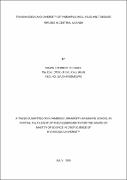| dc.description.abstract | Pineapple mealybug wilt disease (PMWD) is one of the latest breakouts of diseases attacking pineapple in Uganda. Although, first reported around 2009, the etiology and epidemiology is not fully elucidated. Pineapple mealybug wilt disease was reportedly devastating in the districts of Mukono and Kayunga with incidence ranging from 15 to 100%, respectively. The causal viruses of PMWD belong to the genus Ampelovirus. However, information on the transmission and diversity of the causal viruses of pineapple mealybug wilt disease in Uganda is limited and scanty. Therefore, this study was undertaken to (1) identify and characterise the diversity of viruses associated with PMWD, (2) determine mealybug action threshold for transmission of PMWD and (3) identify sources of resistance to PMWD. Forty four (44) symptomatic pineapple plant leaves were collected from the districts of Masaka, Luwero, Kayunga and Mukono in central Uganda for laboratory analysis. Molecular analysis using polymerase chain reaction (PCR) was done to identify and assess the diversity of pineapple mealybug wilt disease causal viruses. Total plant RNA was extracted using Cetyltrimethyl ammonium bromide (CTAB), the heat-shock protein 70 homolog (Hsp 70h) gene of causal virus was amplified by RT-PCR using specific primer pair 225/226 for PMWaV-1 and 223/224 for PMWaV-2, respectively. Polymerase chain reaction products were separated by electrophoresis and the resulting amplicons were sequenced using Sanger method. The action threshold for transmission of PMWD was assessed using pineapple variety Smooth cayenne inoculated with five levels of viruliferous mealybugs 0, 1, 5, 10 and 15, respectively. The experiment was arranged in a completely randomised design (CRD) with eight replications. Screening for resistance to PMWD was done on five pineapple varieties (Smooth cayenne, Red Spanish, MD2, Sassilimu and Victoria) inoculated with 15 viruliferous mealybugs. Data was subjected to AMOVA and ANOVA for genetic diversity and action threshold and resistance, respectively. Results showed that only PMWaV-1 was associated with pineapple mealybug wilt disease in
central Uganda. Accordingly, high PMWD transmission was recorded in 15 mealybugs. There was significant difference (P˂0.05) in resistance among the pineapple varieties. Red Spanish was highly resistant while Sassilimu, MD2 and Smooth cayenne was moderately resistance and Victoria highly susceptible. The results of this study have therefore shown that only PMWaV-1 was associated with PMWD in central Uganda. The mealybug action threshold for the transmission of PMWD is 15. The study also revealed that the sources of resistance to PMWD are variable although Red Spanish was highly resistant. The implications of these findings therefore is that an effective management strategy against PMWD can be instituted based on the identified and characterized causal virus and action threshold of mealybug as well as the sources of resistance identified. However, there is need for additional studies to unravel genetic diversity using more samples as well as the molecular basis for resistance of pineapple varieties to PMWD. | en_US |

